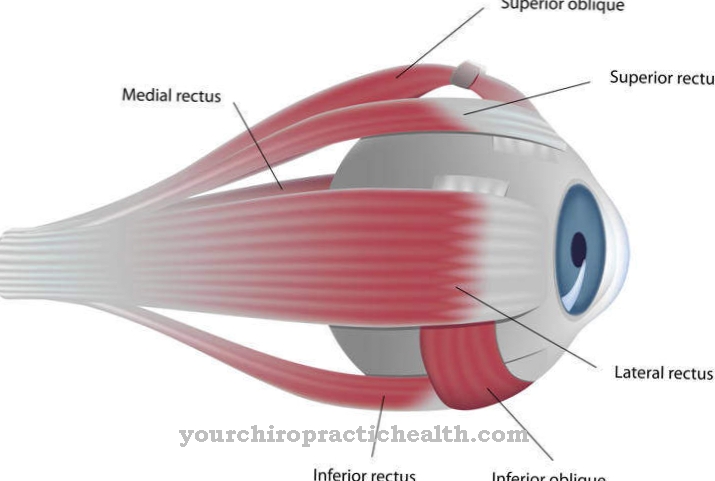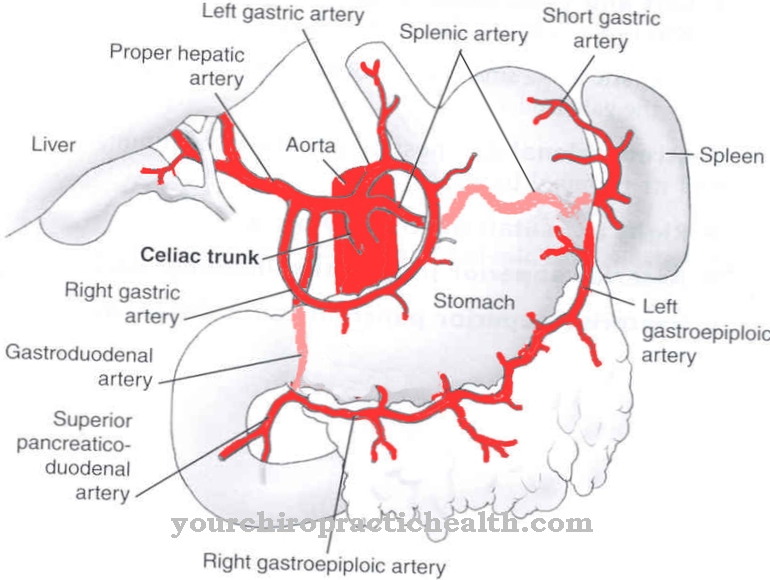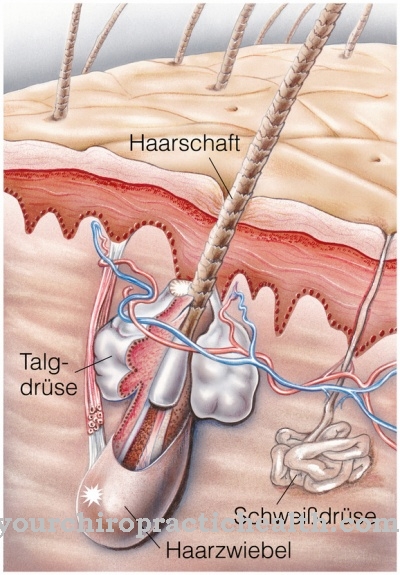Lymph glands are part of the lymphatic system and are assigned to the secondary lymphatic organs. They are therefore part of the immune system and play an important role in the defense against infections from bacterial and viral germs. They filter or purify the lymph released from the bloodstream and guide it back again, with the provision and activation of B and T lymphocytes and macrophages playing a major role.
What are the lymph glands?
Lymph glands are also synonymous as Lymph nodes referred to because they are not glands in the original sense, but as part of the lymphatic system they take on an important function of the body's own immune system by keeping and controlling the activation and reproduction of special white blood cells such as B and T lymphocytes.
Lymph glands filter the lymph (tissue fluid) released from the bloodstream into the tissue, examine it for infectious viruses or bacteria and for degenerated body cells. The lymph then returns to the bloodstream. The lymph glands usually reach a size of 5 to 10 mm, but can be almost double the size on the neck and groin.
The frequency distribution of the lymph glands, each of which “looks after” and monitors a certain region of the body, is uneven. Important regions for lymphatic glands are the head, neck and armpit as well as the abdomen and chest. Many lymph glands can be felt from the outside as small, inconspicuous tissue thickenings. If the lymph glands have recognized germs of infection in the lymph, they can become active and swell significantly.
Anatomy & structure
Lymph glands usually have an elongated oval, kidney-like shape and are surrounded by a firm connective tissue capsule from which the septa (trabecula) extend into the interior of the lymph gland. The interior of the lymph glands consists of very fine lymphatic tissue, which consists of reticular cells and free lymphocytes. The tissue is divided into three layers, the cortex, the middle paracortical zone and the inner marrow.
The lymph glands are traversed by cavities, the lymph sinus, in which the lymph moves from one station to the next. The so-called primary lymph from the surrounding tissue is collected in lymph vessels that reach into the lymph glands as vas afferentia. After the lymph has been processed inside the lymph glands, the lymph leaves the lymph gland via the centrally located vas efferens through the hilar and is either directed to a collecting lymph gland or back into the bloodstream.
In the individual layers of the lymph gland there are different lymphocytes such as B and T lymphocytes, while macrophages are found in the marrow. The lymphocytes can be activated very quickly and, depending on the type of threat, differentiate and intervene as part of the immune response.
Function & tasks
The main task and function of the lymph glands is to absorb tissue fluid and to check it for any pathogenic viruses, bacteria or degenerated body cells or other harmful substances. The rather smaller regional lymph nodes absorb the so-called primary lymph from the surrounding tissue and, after a certain processing, forward it to so-called larger collecting lymph glands, which process the lymph from several or many regional lymph glands and channel them back into the bloodstream.
If the risk of infection from harmful viruses or bacteria is recognized, the lymphocytes in the lymph glands react with the agents of the immune system. By phagocytosis, harmful particles are first enclosed (eaten) in the phagocytes and, if possible, later broken down into harmless pieces by enzymatic means and excreted. Another method of fighting is direct attack via antigens. In addition, z. B. T cells are able to summon help from other parts of the body if necessary.
Cytotoxic T cells, which can mainly identify infected endogenous cells and degenerate cancer cells, have the ability to produce certain cytokines (messenger substances) that trigger apoptosis, preprogrammed cell death, in the endogenous cells recognized as infected or degenerate. The immune reactions can also consist of causing the body to develop a fever, because many viruses are very temperature-sensitive and biochemical processes in the body are significantly accelerated at elevated temperatures, so that two effects are achieved at the same time.
You can find your medication here
➔ Medicines against swelling of the lymph nodesDiseases
As part of the immune system, the lymph glands or their lymphocytes are often involved in immune reactions, which is usually associated with palpable and sometimes painful swellings of the affected lymph glands. If all lymph glands are swollen, it indicates a systemic problem affecting the entire body metabolism.
The systemic response of the lymph glands can e.g. caused by a viral disease such as rubella or glandular fever, or a bacterial disease. Similar symptoms also show up some time after an AIDS infection. In the case of local infections and inflammations, only certain lymph glands that are “responsible” for the infected tissue are usually affected. One example is respiratory infections, in which mainly the throat lymph glands show symptoms and can swell painfully. It is very rare that the lymph glands themselves become sick and therefore develop corresponding symptoms, but cancers that originate in the lymphatic system are more common.
These are so-called lymphomas, which can be less to very aggressive. A distinction is made between Hodgkin's lymphoma and non-Hodgkin's lymphoma. Both forms are initially expressed in systemic painless swellings of the lymph glands. Another variant of a less malignant lymphoma is chronic lymphocytic leukemia. Despite the often aggressive development of lymphomas, the types of cancer can now be treated with chemotherapy and radiation therapy with a good prognosis. In other types of cancer that tend to metastasize, the degenerate cancer cells may end up in the lymphatic system and form metastases there.
Typical & common lymph node diseases
- Glandular Pfeiffer fever
- Swelling of the lymph nodes
- Burkitt lymphoma
- Inflammation of the lymph nodes
- Lymphangitis



























